Graffiti Artists and Radical Media
Graffiti as Radical Media
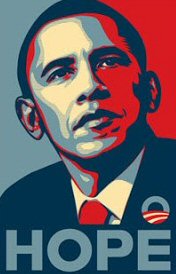 According
to Downing, radical media is a form of media that is “relatively free from the
agenda of the powers that be, and sometimes in opposition to one or more element
in that agenda” (Downing, 8). It is hard to define a solid boundary for radical
media though, lines become blurred when we introduce the concept of audiences.
Looking at this concept we must look at the ideas of time scale and social
movement. Radical media tends to portray the fact that a certain kind of change
needs to happen urgently, which brings us to the idea of social movement.
Radical media which takes on many forms, can help to solidify the concepts of a
social movement, and it can help to unify people within the movement by bringing
about social change. Graffiti is an excellent example of radical media, in that
it originates from outside of the mainstream media leaving an audience with a
powerful message. According
to Downing, radical media is a form of media that is “relatively free from the
agenda of the powers that be, and sometimes in opposition to one or more element
in that agenda” (Downing, 8). It is hard to define a solid boundary for radical
media though, lines become blurred when we introduce the concept of audiences.
Looking at this concept we must look at the ideas of time scale and social
movement. Radical media tends to portray the fact that a certain kind of change
needs to happen urgently, which brings us to the idea of social movement.
Radical media which takes on many forms, can help to solidify the concepts of a
social movement, and it can help to unify people within the movement by bringing
about social change. Graffiti is an excellent example of radical media, in that
it originates from outside of the mainstream media leaving an audience with a
powerful message. Graffiti Background
Graffiti first became recognizable to the mainstream in the 1980’s in New York
city. It began as a form of counter-culture in areas neglected by advertisers,
where the artists used their work to communicate with their audience. It was in
these low-income neighborhoods that empty billboards began to be used by
graffiti artists to send a message. These pieces did not have much intrinsic
aesthetic value, but they declared a message to the people who could read and
understand them. Today this form of “art” is seen all across the world in
countries like Syria, Libya, Egypt, Palestine, and Haiti. While in the Western
world graffiti has evolved and turned into an aesthetically pleasing wonder
while still maintaining its message. In second and third world countries it
maintains the basic elements of lines, scribbles and words serving as a perfect
example of radical media. Graffiti can be scrawled hastily to stir rebellion,
cause incitement, and beg for freedom.

As with any form of media or technology, graffiti has evolved over the years.
It started out as a guy with a spray can tagging a wall or a train car, but has
transitioned into premeditated projects involving pasting up prepared posters or
using stencils. This allows the street art to be placed in many more locations,
decreases completion time, and decreases the chance of being caught by authority
figures. This allows the artist to be more bold with their statements as well as
to use more visual cues to help push their ideas. The artists I am going to
discuss used their pieces to make statements about government, religion, art,
war, society and so much more.
Banksy
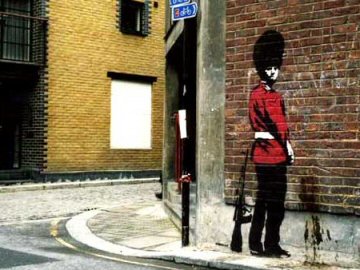 By
far the most famous name in the street art scene for several years now is Banksy.
He is based in Bristol, England and has been pulling stunts and spraying
stencils since the mid 90’s in many cities across the globe. Marc Schiller, who
runs a US based graffiti website stated, “Every once in a while, you meet
someone who can do things other people can’t do, and I put Banksy in that
category. Graffiti is something very inaccessible; it’s not something everyone
likes or understands. But Banksy’s work appeals to everyone; it crosses cultural
borders and age,” (Gopnick). Banksy is constantly pushing the envelope and
reaching for that next big statement he can make whether it is about capitalism,
war or famine. By
far the most famous name in the street art scene for several years now is Banksy.
He is based in Bristol, England and has been pulling stunts and spraying
stencils since the mid 90’s in many cities across the globe. Marc Schiller, who
runs a US based graffiti website stated, “Every once in a while, you meet
someone who can do things other people can’t do, and I put Banksy in that
category. Graffiti is something very inaccessible; it’s not something everyone
likes or understands. But Banksy’s work appeals to everyone; it crosses cultural
borders and age,” (Gopnick). Banksy is constantly pushing the envelope and
reaching for that next big statement he can make whether it is about capitalism,
war or famine.
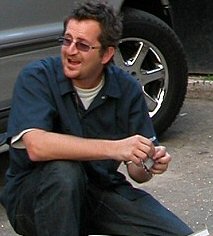 Bansky
generally uses his wit and his creativity to make statements he feels the world
should see. One of his earliest and most admired pieces relates very well with
present times, even though it was painted in the late 90’s. It is a painting of
a teddy bear throwing a molotov cocktail at a group of riot police, with the
text, “The Mild, Mild West....” He used this piece to showcase the unnecessary
violence the police used to break up a group of peaceful party goers in Ashton,
England. The bear is representative of the group’s mellow attitude while the
bomb suggests that they will fight for their freedoms if need be. This can so
easily relate to the Occupy Wall Street movement that has gained popularity in
the past few years . Hundreds of peaceful protesters have been violently
assaulted by police forces, however they have not chosen to “fight back” which
has made their case incredibly strong. Banksy also has a piece that speaks to
this non violence, a “rebel” with his arm stretched back ready to throw but
instead of a bomb he is holding a bouquet of flowers. Bansky
generally uses his wit and his creativity to make statements he feels the world
should see. One of his earliest and most admired pieces relates very well with
present times, even though it was painted in the late 90’s. It is a painting of
a teddy bear throwing a molotov cocktail at a group of riot police, with the
text, “The Mild, Mild West....” He used this piece to showcase the unnecessary
violence the police used to break up a group of peaceful party goers in Ashton,
England. The bear is representative of the group’s mellow attitude while the
bomb suggests that they will fight for their freedoms if need be. This can so
easily relate to the Occupy Wall Street movement that has gained popularity in
the past few years . Hundreds of peaceful protesters have been violently
assaulted by police forces, however they have not chosen to “fight back” which
has made their case incredibly strong. Banksy also has a piece that speaks to
this non violence, a “rebel” with his arm stretched back ready to throw but
instead of a bomb he is holding a bouquet of flowers.
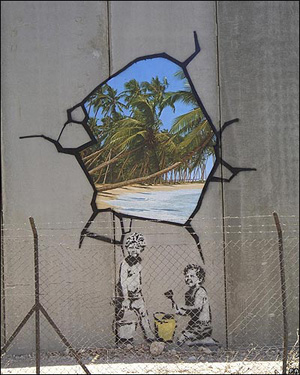 Another famous work Banksy created was in Bethlehem, on the concrete barrier,
in 2005 during the height of political and religious conflict in the area. This
piece looked like someone dug through the wall to show paradise beyond. Banksy
did a couple of other works on this wall in the West Bank, all showing a break
in the wall and a more beautiful place where freedom could be obtained. He has
done many controversial pieces in countries all across the world, and as Marc
Schiller stated he is enjoyed by many people from different walks of life. His
messages speak to society and allow us to share our thoughts about heavy
subjects which in other times and spaces have been taboo. Another famous work Banksy created was in Bethlehem, on the concrete barrier,
in 2005 during the height of political and religious conflict in the area. This
piece looked like someone dug through the wall to show paradise beyond. Banksy
did a couple of other works on this wall in the West Bank, all showing a break
in the wall and a more beautiful place where freedom could be obtained. He has
done many controversial pieces in countries all across the world, and as Marc
Schiller stated he is enjoyed by many people from different walks of life. His
messages speak to society and allow us to share our thoughts about heavy
subjects which in other times and spaces have been taboo.
OBEY
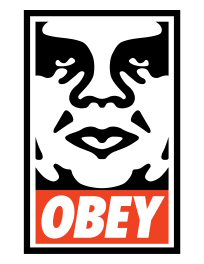 The
next artist who has had a serious impact on society with his street art is
Shepard Fairey, more commonly known as OBEY. He follows a similar path as Banksy
in that his pieces are generally large murals, which often times commissioned as
opposed to placed illegally. Fairey started out the same way as all street
artists, placing posters and stickers or spraying illegally on buildings,
however his work has less of a sarcastic wit and more of a profound statement to
it. This brought him into light as a spokesperson for the downtrodden and
wronged classes in America’s society as well as a huge anti-war supporter. The
next artist who has had a serious impact on society with his street art is
Shepard Fairey, more commonly known as OBEY. He follows a similar path as Banksy
in that his pieces are generally large murals, which often times commissioned as
opposed to placed illegally. Fairey started out the same way as all street
artists, placing posters and stickers or spraying illegally on buildings,
however his work has less of a sarcastic wit and more of a profound statement to
it. This brought him into light as a spokesperson for the downtrodden and
wronged classes in America’s society as well as a huge anti-war supporter.
OBEY derived his name from the John Carpenter film, They Live, where an
unemployed construction worker finds a pair of special sunglasses. The
sunglasses display the subliminal commands of those in power on billboards and
advertisements across the country. It was the beginning of a war against the
establishment and it had a big influence on Shepard Fairey. He felt that the
movie had an oddly profound message despite it’s campiness, which was that
society is being blindly manipulated and if one could just see past the surface
they would recognize this fact. He began his street art campaign using the word
OBEY, saying he wanted to mimic advertising but without a product.
He is a very good example of the counter-culture becoming mainstream, as he
is most famously known by mass audiences, not just within the street art scene,
for his HOPE poster. This was a poster he designed for Barack Obama’s
presidential campaign in 2008. Shepard began fine tuning his messages to
political statements around 2003, starting with anti-war posters and following
those up with anti Bush posters in 2004. The Obama poster was actually his first
poster in favor of something or someone and not against someone or something and
it really pushed Fairey well beyond his usual audiences, bringing his message to
not only his art fans and followers but millions of people across the United
States.
Beginning with this campaign, his commercial empire has had much success. He
has done graphic design work for Absolut, Queens of the Stone Age, and Guitar
Hero as well as having a line of clothing that is enormously popular as well as
fairly expensive. There have been complaints from his followers that he is
selling out. Fairey responds to these charges that he is not, that “it hurts my
feelings that people don’t recognize that I’m doing my commercial work with the
best intentions, in an ethical way, and still making my artistic point” (Bearman).
He also says that he does work for corporations and uses that money to fund OBEY
and gives out a lot of other items for free. This raises the question of
crossing over into mainstream territory. When the message is no longer radical
although it’s delivery may still be, is it still a rebellion? Fairey argues that
there is power in mass-media and he even quotes Marshall McLuhan saying, “The
medium is the message.”
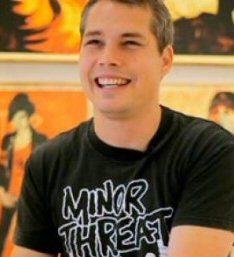 He has really taken the next step to show his “grassroots” are still intact,
doing a lot of work for the Occupy Wall Street movement that has taken off over
the last couple of years. He altered his famous Obama Hope poster calling for
Obama’s support for the movement. He released the image, in which Obama’s face
replaced with a figure wearing the Guy Fawkes mask, with the quote, “this image
represents my support for the Occupy movement, a grassroots movement spawned to
stand up against corruption, imbalance of power and failure of our democracy to
represent and help average Americans. On the other hand, as flawed as the system
is, I see Obama as a potential ally of the Occupy movement if the energy of the
movement perceived as constructive, not destructive. Mister President, we HOPE
you’re on our side” (NG). He has really taken the next step to show his “grassroots” are still intact,
doing a lot of work for the Occupy Wall Street movement that has taken off over
the last couple of years. He altered his famous Obama Hope poster calling for
Obama’s support for the movement. He released the image, in which Obama’s face
replaced with a figure wearing the Guy Fawkes mask, with the quote, “this image
represents my support for the Occupy movement, a grassroots movement spawned to
stand up against corruption, imbalance of power and failure of our democracy to
represent and help average Americans. On the other hand, as flawed as the system
is, I see Obama as a potential ally of the Occupy movement if the energy of the
movement perceived as constructive, not destructive. Mister President, we HOPE
you’re on our side” (NG).
Along
with showing support for the Occupy movements he selected to inaugurate the
Artist as Activist series put out by the Robert Rauschenberg Foundation. One
hundred signed prints of the newest Fairey poster, “The Future is Unwritten”
will be sold at an online auction with most of the proceeds going to help the
nonprofit organization Coalition for the Homeless. While it is still debatable
due to his enormous success and commercial endeavors, Fairey obviously makes an
effort to show his thoughts and ideals in every piece he creates. Whether it is
a message against war or a political statement of hope or a call to arms for a
major social movement, he maintains his standards and uses his name and art to
reach a massive audience to enact social change.
J.R.
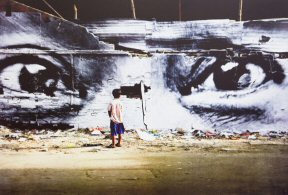 J.R.
is a French artist, who does incredible work but is not as well-known as Banksy
or Obey. He owns the biggest art gallery in the world and exhibits his work all
across the globe. He began humbly, by taking photos in Europe and observing the
people there. He is best known for creating massive photos of the downtrodden
and unaccepted people of society and plastering these photos over entire
buildings. He worked on a project he called “Women” in which he focused on the
dignity of women who often are most affected by conflicts around the world. J.R.
is a French artist, who does incredible work but is not as well-known as Banksy
or Obey. He owns the biggest art gallery in the world and exhibits his work all
across the globe. He began humbly, by taking photos in Europe and observing the
people there. He is best known for creating massive photos of the downtrodden
and unaccepted people of society and plastering these photos over entire
buildings. He worked on a project he called “Women” in which he focused on the
dignity of women who often are most affected by conflicts around the world.
 He
makes it his goal to not only show the world the downfalls in society but to
include that same society’s members as well. By using photos of members of the
community and allowing children and other people to help distribute and put up
his work, he is bringing the message of his work that much closer to home. After
his works have exhibited locally they are transported to large cities such as
New York, Los Angeles and London, where people in these communities can look
upon them and interpret them in their own ways. This act spreads his message
even farther around the world. J.R. has stated that his wish is “for people to
stand up for what you care about by participating in a global art project, and
together we’ll turn the world... inside out” (Public Art Review, 74). He
makes it his goal to not only show the world the downfalls in society but to
include that same society’s members as well. By using photos of members of the
community and allowing children and other people to help distribute and put up
his work, he is bringing the message of his work that much closer to home. After
his works have exhibited locally they are transported to large cities such as
New York, Los Angeles and London, where people in these communities can look
upon them and interpret them in their own ways. This act spreads his message
even farther around the world. J.R. has stated that his wish is “for people to
stand up for what you care about by participating in a global art project, and
together we’ll turn the world... inside out” (Public Art Review, 74).
Morley
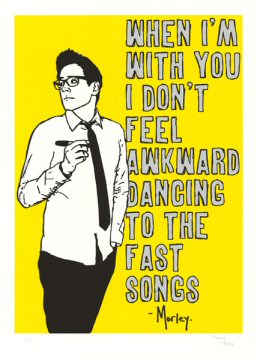 The
last artist I want to talk about is much smaller in scale, and he makes more of
a social statement than political. His name is Morley and he is from Los
Angeles, California. He has a day job, and in his spare time he creates posters
and hangs them all over L.A. More recently he has gotten his prints in London
and throughout Spain through trips abroad and friends of his living in other
countries. He has also signed with a company who used to represent Banksy, to
create several runs of screen printed posters available for sale. His posters
consist of a hand drawn picture of himself, writing whatever the message of a
particular piece is. In this way he feels he can connect with the audience by
leaving messages of hope and concern for society to read and (hopefully) ponder. The
last artist I want to talk about is much smaller in scale, and he makes more of
a social statement than political. His name is Morley and he is from Los
Angeles, California. He has a day job, and in his spare time he creates posters
and hangs them all over L.A. More recently he has gotten his prints in London
and throughout Spain through trips abroad and friends of his living in other
countries. He has also signed with a company who used to represent Banksy, to
create several runs of screen printed posters available for sale. His posters
consist of a hand drawn picture of himself, writing whatever the message of a
particular piece is. In this way he feels he can connect with the audience by
leaving messages of hope and concern for society to read and (hopefully) ponder.
Most of the time, Morley’s statements make an effort to include the viewer or
to draw them into the message. He often leaves messages of hope such as, “It
will get better” or “This is not it.” His thinking behind these pieces is that
even if only one person sees his art and it can change their way of thinking or
make their day a little less stressful, he has succeeded. In the L.A. street art
scene there is a lot of competition. Walls get buffed by the city often and it
is then a race to see who can get their new piece up first, and hopefully not
get covered up by the next day. Electrical boxes are constantly being covered
and recovered so that there are inches of layers of paper on them. The difficult
part is creating something meaningful that the audience will get some hope for
the future, for their life, for the understanding of it all.
He too puts Marshall McLuhan in high regard, making a poster out of his
statement, the medium is the message. As Morley puts it, “the form of a medium
embeds itself in the message, creating a symbiotic relationship by which the
medium influences how the message is perceived” (Morley). Morley’s poster says,
“The Median is the Message” and it is placed on a median on Highway 110
northbound in Los Angeles, California. He left it as a message for people to
read as they often get stuck in traffic on this highway and would have time to
not only read the poster but to think about it’s meaning as well.
He has had a few posters that lead the audience to think about the
advertising industry in our society today. One says, “I apologize for not trying
to sell you something,” another says “I pledge allegiance to the ads,” and a
third stating that “The revolution will have commercials.” With these posters he
is trying to get society to notice how overrun we have become by advertising and
consumerism. He uses the unique and simple way of street art to get a thoughtful
message out to members of his community and he takes the time to figure out
where specific posters will have the greatest effect.
Graffiti as Radical Media
Graffiti works as a radical media on two levels. First it is an unusual way to
reach a large audience including some members who are harder to reach by other
methods of radical or mass- media. Graffiti is enticing and may give people a
reason to stop, look at it and then think about its message. Second it grasps an
even larger audience because the original audience often takes photos or videos
of the art or writes articles about it in newspapers, magazines or blogs. This
increases the reach of the message behind the graffiti. It has now trickled
through other radical media outlets and even some mass media outlets and
influences an untold amount of people. The artists are fully aware of this and
they take any opportunity to get their work on the streets and leave what they
consider an important message, whether it is political, satirical or social.
Graffiti is an excellent example of radical media in the 20th century and for
the years to come. Street artists are consciously breaking the law and using
their free agency to break the structure of society to get out a message that
they are repressed among the typical mass-media outlets, or are not reaching the
target audience that the information most effects. Street art is often used to
bring an audience closer to making an effort. Many times this effort has
produced greater results than expected and becomes part of the mainstream,
however most artists try to keep their original thoughts and messages in the
pieces regardless of how mainstream they have become. There are multiple levels
of graffiti ranging from the vandals who just leave sprayed scrawls on walls and
electrical boxes just to be deviant, there are the people who care solely about
the aesthetics of a piece and are not really leaving a lasting and meaningful
message, and last there is the level which Banksy, OBEY, J.R. and Morley are
notably a part of, who put themselves at risk in hopes of making a positive
social change.
Conclusion
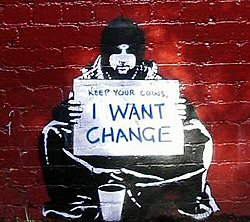 This
form of radical media not only creates a public sphere that is not effected by
government or the economy but it promotes a solidarity among it’s viewers.
Street artists take pride in erasing the false consciousness of a society and
working against the oppressive force of that society. The graffiti of artists
like Banksy or OBEY often make fun of or
point out the inequality of the government and economy and the impact that
advertising has had on our society. They try to extinguish the margin of
difference between the world as it is commonly portrayed and they way it truly
is. For all these reasons, graffiti is a very acceptable and noble form of
radical media. This
form of radical media not only creates a public sphere that is not effected by
government or the economy but it promotes a solidarity among it’s viewers.
Street artists take pride in erasing the false consciousness of a society and
working against the oppressive force of that society. The graffiti of artists
like Banksy or OBEY often make fun of or
point out the inequality of the government and economy and the impact that
advertising has had on our society. They try to extinguish the margin of
difference between the world as it is commonly portrayed and they way it truly
is. For all these reasons, graffiti is a very acceptable and noble form of
radical media.
Works Cited
Downing, John. Radical Media Rebellious: Communication and Social Movements.
California: Sage Publications, Inc. 2001. Print.
Wright, Steve. Banksy’s Bristol Home Sweet Home. UK: Tangent Books. 2007. Print.
Gopnick, Blake. “Revolution in a Can.” Foreign Policy Nov. 2011: 92-93. Print.
Gaddy, James. “Nowhere Man.” Print Jan/Feb 2007: 68-73. Print.
Bearman, Joshuah. Modern Painters October 2008: 68-73. Print.
NG, David. Los Angeles Times Blog. Los Angeles Times, Nov. 21, 2011. Web. April
18, 2012.
Heyman, Stephen. Poster Boy. New York Times, Nov. 13, 2011. Web. April 18, 2012.
Morley. I Am Morley. Web. April 18, 2012.
J.R. www.jr-art.net. Web. April 25, 2012.
Forecast Public Artworks JR Wins Ted Prize. 22 .2 .44 (2010):74 Print.
Art
Graffiti Artists and Radical Media
Marcel Duchamp's Fountain
The Genius of
Jan Van Eyck |